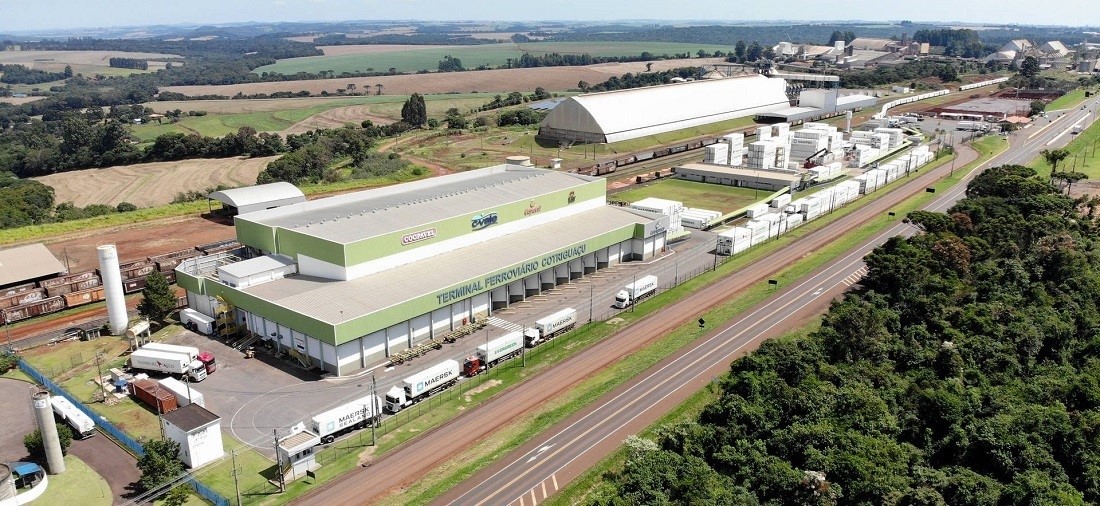
New infrastructure assets to boost cargo flow to Paranagua Port
Oct, 25, 2023 Posted by Gabriel MalheirosWeek 202343
The increasing volume of grains produced in Mato Grosso do Sul has positioned this state as the second-largest user of the Port of Paranagua, trailing only the state of Paraná. Forecasts point that the volume will further rise upon the implementation of the strategic infrastructure projects by the Government of Paraná aimed at enhancing cargo unloading logistics in the port. Two such projects are the New Ferroeste, a railway line connecting the town of Maracaju (MS) directly to Paranaguá, and the Moegão, a grain reception structure designed to receive products that arrive by rail. Between January and July this year, the port in Paraná recorded a 32% increase in cargo throughput, primarily driven by soybeans, followed by soymeal and corn.
The New Ferroeste will link Maracaju and Paranaguá by rail lines and will feature two branches: Cascavel – Foz do Iguaçu and Cascavel – Chapecó (SC). In total, the rail network will span 1,567 kilometers, providing an alternative to the current dominance of road transport. Meanwhile, the Moegão is a large rail unloading area for grains and meals at the port, eliminating the need for breaking up train compositions. This project will connect the 11 terminals that comprise the Eastern Export Corridor, resulting in a 63% increase in unloading capacity. Together, these two projects offer a more cost-effective, efficient, and environmentally friendly mode of freight transportation, bolstering the attractiveness of the Port of Paranaguá.
Currently, grain transportation from Mato Grosso do Sul is primarily reliant on road infrastructure. In the first half of this year, 36,257 trucks from that state brought cargo to Paranaguá. Up to July this year, 14.5 million tons had been exported. Out of this total, 28% were shipped from Paranaguá to destinations such as China, South Korea, and Bangladesh. In a geographically vast country like Brazil, freight costs for transporting inputs and products play a crucial role in market competitiveness. The coastline of Paraná serves as the gateway for commodities like grains, pulp, and animal protein, which often need to travel more than a thousand kilometers to reach international vessels.
See below soy exports from the Port of Paranagua between Jan 2019 and Aug 2023. The data is from DataLiner.
Soy exports from Paranagua Port | Jan 2019 – Aug 2023 | WTMT
Source: DataLiner (click here to request a demo)
The feasibility study for the New Ferroeste project indicates that rail transport becomes more favorable than road transport after the 350-kilometer mark. This distance accounts for approximately 85% of the cargo accessing the Ports of Paraná, a substantial portion of which originates in Mato Grosso do Sul. In Western Paraná, there is also a real and urgent demand for an expanded and more efficient rail network, especially for the transportation of animal protein. Currently, the existing Ferroeste section connects Cascavel in the West to Guarapuava. With a length of 248 kilometers, the line connects to the Southern Rail Network in Guarapuava and runs down to the coast. At present, a reefer container with animal protein can take up to five days to travel from Cascavel to Paranaguá. The difference in freight costs in comparison to road transport justifies the choice. The truck route from Cascavel to Paranaguá costs R$5,800, whereas the train freight is priced at R$4,500.
According to the Paraná Container Terminal (TCP), in 2022, Cotriguaçu (responsible for transporting cooperatives Copacol, C.Vale, Lar, and Coopavel) shipped 45,752 twenty-foot containers by train, averaging 3,812 containers per month. This year, until August, 32,742 containers from Cotriguaçu have been dispatched, with a monthly average of 4,094, suggesting that 2023 is likely to surpass last year’s volume.
Giovanni Guidolim, the logistics manager at TCP, notes a consistent growth in the number of refrigerated containers transported by this mode. “Western Paraná is a major export hub for the state’s agribusiness. Today, only 20% of the cargo for export reaches the port by rail. Out of this, only 10% originates in the West. There is a substantial unmet demand in the region. Cotriguaçu is a prime example, as it primarily relies on road transport, incurring higher freight costs due to rail’s limited capacity,” says the coordinator of the state’s railway plan, Luiz Henrique Fagundes.
-
Grains
Oct, 24, 2023
0
Gov’t approves measures to speed up wheat customs clearance at Santos Port
-
Ports and Terminals
Mar, 06, 2024
0
ANTAQ Sets Date for Public Hearing on Itajaí Port Concession
-
Sep, 13, 2024
0
High Melon Exports Drive Up Prices and Tighten Domestic Supply, Cepea Reports
-
Ports and Terminals
Aug, 13, 2024
0
Bahia State Port Breaks Record for First Half of The Year

